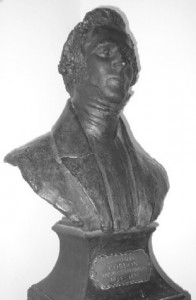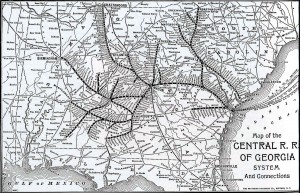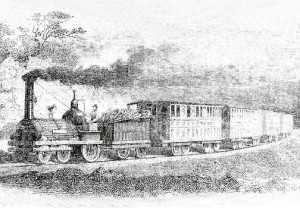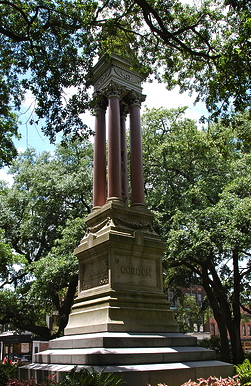Juliette “Daisy” Gordon Low is descended from a goodly number of individuals who believed that, as George Washington once wrote, “happiness and moral duty are inseparably connected.” No one personified that connection like William Washington Gordon I, Juliette Low’s paternal grandfather. In recognition of all he did for the city of Savannah and the state of Georgia, Daisy sculpted a bust of him. She insisted it be placed in Savannah’s City Hall, where it remains today.
William Washington Gordon I was born to Elizabeth Meade and Ambrose Gordon on 17 January 1796, at the tail end of the eighteenth century. Ambrose’s Revolutionary War service gave him such an admiration for the man under whom he served, General George Washington’s nephew, William Washington, that he named his first-born son after him and called him “Washington.” It also gave him an expanse of land in Georgia, which is why that son was born in Augusta rather than his father’s home state of New Jersey.
Washington Gordon maintained his ties with the north through his schooling in Rhode Island and later in New York, when he became the first Georgian to graduate from the United States Military Academy at West Point. Law was of greater interest than the military, however, and by the time he was 24 he had been admitted to the bar. Thus began a career of public service that included two years as a recorder in Savannah’s Police Court, three years as city alderman, a term as Savannah’s mayor, an elected member of the Georgia House of Representatives and later the Georgia Senate, and—like his father before him—leadership in the Georgia Hussars.
In 1826 Gordon married Sarah Anderson “Addy” Stites, the daughter of Mary Wayne and Richard Montgomery Stites, a Savannah attorney. Addy’s uncle, Judge James Moore Wayne, built the home in which Washington and Addy lived—the home that is now the Juliette Gordon Low Birthplace. Four of the Gordon’s seven children lived to adulthood.
Washington Gordon is best remembered as a founder of the Central of Georgia Railroad and Banking Company. In the 1830s, when railroads were new, the far-sighted Gordon used his legal acumen and his network of like-minded associates to build a line that would bring cotton from the hinterlands to the Port of Savannah. He was in a virtual race with a railway line in South Carolina that threatened to steal the cotton export traffic and route it through Hamburg—on the South Carolina side of the Savannah River near Augusta.
In March 1836, Washington Gordon became the Central of Georgia’s first president and in that year work began on the railroad. According to historian Charles J. Johnson, Gordon “traveled constantly throughout the state supervising construction, negotiating rights-of-way with planters, and dealing with labor disputes.” (1) Financial depressions and natural disasters beset the enormous engineering feat, and Washington Gordon died just months before the line was completed in 1843.
What his Central of Georgia Railway did to seal the economic success of antebellum Georgia is difficult to overestimate. He was honored in 1850 when Gordon County was named after him. If you travel to Savannah today, you will see visible proof in Wright Square: the Central of Georgia monument to William Washington Gordon. It is a tall, elegant memorial made of red granite and limestone. According to the Central of Georgia Board of Directors, the four winged figures at the top “represent Agriculture, Manufacture, Commerce and Art…and are bearing, typically, the world of our day, forward with great rapidity to a state of unequalled prosperity.” (2)
Most recently, William Washington Gordon has been inducted into the National Railroad Hall of Fame (NRRHF) for his contributions to U.S. railroad history. Full disclosure: I nominated him. Really full disclosure: my husband, Simon Cordery, is chair of the nominating committee of the National Railroad Hall of Fame! However, he has nothing to do with who actually gets admitted to the Hall of Fame. That decision is made by the Board of Directors of the National Railroad Hall of Fame. Click here to see Washington Gordon at the NRRHF–including his portrait.
By the way, there is a whole other story about the Wright Square monument in Savannah and it also concerns moral and civic duty, but since it’s really Daisy’s mother’s story, we’ll save it for another blog.
____________
(1) Charles J. Johnson, Jr., “William Washington Gordon,” Bio File—Gordon, Georgia Historical Society, Savannah, Georgia.
(2) “Gordon Monument,” Copy of the Central of Georgia Board of Directors Minutes, 12 July 1883, Monuments/Memorials—Savannah, Gordon, Georgia Historical Society.
Photo of Daisy’s bust of her grandfather from the City of Savannah website. Railway map from RailGA.com. Locomotive from GeorgiaInfo.






Excellent story again… Thankyou. I knew there was a way you could bring railways into Daisy’s story.
The efforts of those pioneers in laying down the tracks along certain routes has had, and is still having, an enormous effect on the economic wealth of towns and cities. Savannah wouldn’t be Savannah if the competition to drive the railroad through had been won by the competition. I doubt that they realised the effects of their actions would be felt for centuries.
The romance of railroads transcends time, Clive!
You learn something every day! I have been a Girl Scout for about 65 years and I never knew that James Moore Wayne, who built the Birthplace, was related to Daisy.
Ms. Gardner–thank you so much for reading, and for your comment. I thought about doing an entire blog on James Moore Wayne. Daisy Low was connected to amazing people, that’s for certain!
I’ve been harping for years on how Daisy came from a railroad family, and (with all the emphasis on STEM programs nowadays) how railroading fits into our program, maybe even better than some topics like space exploration that have been emphasized over the years. We explore so much else Daisy and her family brought to the table, it’s almost as if the railroad connection was censored out.
Thank you, Stacy, for outside proof that I’ve not been talking through my hat for the last 35 years!
Thanks, Aggie, for your comment. I’m glad you enjoyed the post. There is SO much one could write about the Gordon men and the Central of Georgia–and about the Gordon women and railroads, too. Your nice comment reminds me that I should write up Nellie’s connection to the Gordon memorial for a blog very soon…Thanks!
Hi,
My great-grandmother was named Dora Gordon Wilkerson, from Rome, GA. I read with great interest the history of W.W.Gordon and the family home. I have no idea how we were related, but would appreciate it if you could send some ancestral information. I am working on our family history for my children.A note of serendipity–I was Cookie Chairman of my daughter’s G.S. Troop thirty years ago before I knew of any connection Thanks!
Diane–Thanks for your comment.
I don’t know how you are related, but as the Gordons moved to Georgia from New Jersey, there’s a good chance you are. You should go see the fabulous archivists and librarians at the Georgia Historical Society in Savannah: http://www.georgiahistory.com/
The bibliography in my book will point you to other sources too, including Huge Golson and Jennifer Ryan, _Andrew Low and the Sign of the Buck_, and Caroline Couper Lovell, _The Light of Other Days_. Neither are specifically on the Gordons, but the Gordons appear. Good luck with your research.